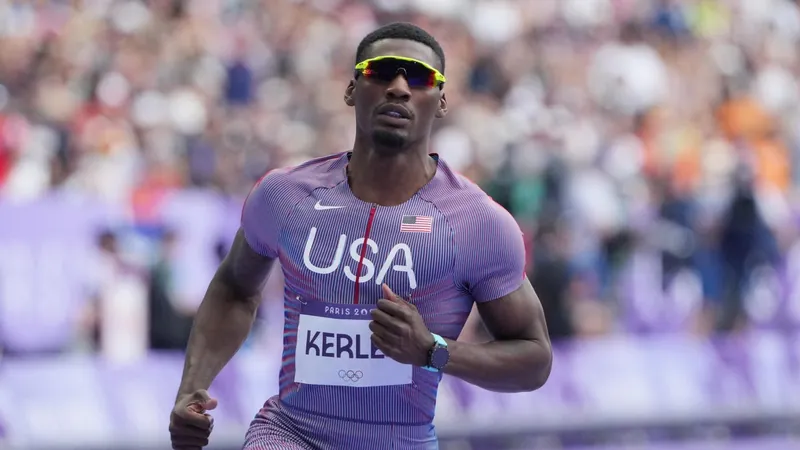
Fred Kerley’s Arrest Ignites Debate Over Police Use of Force: A Familiar Narrative Revisited
2025-01-04
Author: Yan
Introduction
The controversial arrest of Fred Kerley, a renowned Team USA sprinter and Olympic bronze medalist, has sent shockwaves through social media and reignited the ongoing discourse surrounding police use of force in the United States. The incident unfolded in Miami Beach, where body-worn camera footage and witness recordings painted a complex picture of the event.
Many viewers interpreted the footage as depicting Kerley as the aggressor, who allegedly ignored multiple police commands and became confrontational. Conversely, advocates for Kerley argue that he is yet another victim of excessive force used by officers in a situation that could have been de-escalated more effectively.
Kerley, age 29, faced several charges following the encounter, including battery upon a law enforcement officer (a third-degree felony), along with resisting an officer and disorderly conduct (both misdemeanors). During a bond hearing, his attorney, Yale Sanford, characterized the encounter as a misunderstanding, emphasizing the excessive force used by the police. The presiding judge, Mindy Glazer, reportedly expressed skepticism regarding the officers' response, suggesting that the situation could have been managed differently, especially given Kerley’s clean record and status as an Olympic athlete.
What Led to the Kerley Confrontation?
From police accounts, the altercation escalated when Kerley attempted to enter a restricted area while officers were managing an ongoing police scene. The initial moments of the body camera footage lack audio, causing some ambiguity; however, video footage shows Kerley getting close to officers, prompting one officer to create space for safety, to which Kerley responded by moving the officer's hand aside. Subsequently, a physical confrontation broke out involving multiple officers trying to apprehend Kerley.
Miami Beach police spokesperson Christopher Bess defended the officers' actions, stating they acted according to their training in response to the perceived threat, and confirmed that a review of the incident would be conducted as per standard procedure.
A Parallel with Tyreek Hill’s Encounter
Notably, Kerley's arrest echoes a similar incident involving Miami Dolphins star wide receiver Tyreek Hill, who had a tumultuous interaction with police less than five months earlier. Hill was forcibly removed from his vehicle after being pulled over for speeding, leading to narrative comparisons drawn by those familiar with both cases. The legal representation for Hill posited that these incidents reflect a troubling pattern of treatment towards African American individuals by law enforcement, highlighting the imperative for police to emphasize de-escalation techniques.
While some attorneys believe there are similarities in how both athletes were treated, others note significant differences in the circumstances surrounding their encounters. According to attorney Devon M. Jacob, who has a prominent civil rights background, Kerley appeared to initiate contact with officers, which could legally justify his arrest for failing to comply with lawful orders.
Conclusion
As this situation continues to unfold, it serves as a painful reminder of the systemic issues surrounding policing and the urgent need for reform—especially an emphasis on de-escalation strategies. The conversation surrounding the intersection of race and law enforcement in America remains as critical and contentious as ever, forcing society to grapple with uncomfortable truths about accountability and justice.
Stay tuned as more developments occur in both Fred Kerley’s case and the larger implications for policing practices across the nation.


 Brasil (PT)
Brasil (PT)
 Canada (EN)
Canada (EN)
 Chile (ES)
Chile (ES)
 Česko (CS)
Česko (CS)
 대한민국 (KO)
대한민국 (KO)
 España (ES)
España (ES)
 France (FR)
France (FR)
 Hong Kong (EN)
Hong Kong (EN)
 Italia (IT)
Italia (IT)
 日本 (JA)
日本 (JA)
 Magyarország (HU)
Magyarország (HU)
 Norge (NO)
Norge (NO)
 Polska (PL)
Polska (PL)
 Schweiz (DE)
Schweiz (DE)
 Singapore (EN)
Singapore (EN)
 Sverige (SV)
Sverige (SV)
 Suomi (FI)
Suomi (FI)
 Türkiye (TR)
Türkiye (TR)
 الإمارات العربية المتحدة (AR)
الإمارات العربية المتحدة (AR)